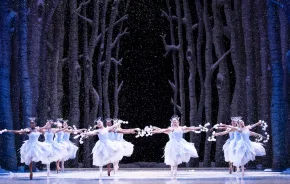
Those who recognize fairy tales as deeply symbolic stories often dismiss Cinderella as an exception — a simple story about a dress. In contrast, Jean-Christophe Maillot’s ballet Cendrillon is about a foot, and it is anything but simple. A dancer’s foot expresses the soul and in Maillot’s ballet, the foot — rather than a glass slipper — is the key to themes that make the ballet Cendrillon, currently in its premiere run at Pacific Northwest Ballet, both deeper and darker than the fairy tale.
Cendrillon is simultaneously a reflection on the private journey of grief and an indictment of artifice in society. In The Year of Magical Thinking, Joan Didion claims that ballet is the only art that adequately communicates the reality of grief. She may have been thinking of Cendrillon. The ballet opens on Cinderella as she remembers the happy, wholesome love her parents shared until her mother’s death. Her movements alternately express the powerful anguish and enervating hopelessness of her loss. Caught in his own grief, her father is unable to comfort her.

Maillot’s stepmother and her daughters are neither ugly nor stupid, but they are superficial and cruel. In contrast to the simple white dress Cinderella's mother wore, these three head off to the ball in elaborate wigs and corsetry. The stepmother’s bustle resembles a scorpion’s stinger — the sisters’ gowns are asymmetrical, reflecting their stunted emotional development.

The prince, in Elvis-invoking white and gold, lives a series of entertainments staged by the Pleasure Superintendents — a duo that provides comic relief throughout the ballet in the form of fake smiles and pretentious courtliness. The prince is searching for meaning, but knowing nothing else, fruitlessly pursues it in diversions.
Every fictional dying mother promises, “I will always be with you.” Maillot fulfills the promise in Cinderella’s fairy godmother, who may be the mother’s spirit, or even the incarnation of her memory. With the help of the Pleasure Superintendents and their mannequins, she tells the story of Cinderella in familiar broad strokes. But when Cinderella tries to wear the mannequin’s gold dress, the fairy godmother stops her.
Instead Cinderella arrives at the ball in her mother’s simple white dress and sparkling bare feet, remembering her mother while moving forward with her own life. Guided by her fairy godmother, Cinderella and the prince avoid the pitfalls of the court, expressing their new love in high lifts and winged kisses. The prince discards his gold jacket and joins Cinderella in simple white. Her father recognizes the fairy as his first wife, and they double the pas de deux of the prince and Cinderella. Cinderella has achieved a love with her prince that her parents once shared — an authentic, joyful partnership, free of power struggles.
After the ball, the prince searches for the barefoot girl until the fairy godmother leads him to Cinderella. The stepsisters, freshly bandaged from plastic surgery, are revealed for the mutilated creatures they are and Cinderella is reunited with the prince. Left behind, her father echoes Cinderella’s heartbroken dance from the prologue. He rejects the manipulative stepmother, choosing to remain alone with his memories.
Parents should know
The ballet is challenging for children — "Parental Advisory: non-traditional themes," states the PNB website boldly. My 8-year-old has seen more ballet than most adults, but she had a hard time following this unfamiliar take on the classic, especially in the first act. Judging by overheard conversations, she was not the only young person confused.
Unlike more traditional story ballets, Maillot never stoops to pantomiming plot points, nor is his work as abstract as many modern choreographers. Rather, his focus on emotional expression blurs the line between acting and dancing. But unlike Romeo et Juliette, which deals with adolescent emotion, Cendrillon addresses profound grief, abusive relationships and the search for meaning amidst jaded ennui. This is fortunately foreign territory to many children, who may therefore not be able to appreciate the depth of this ballet. But when they do encounter these things later in life, they may be a little better prepared from having seen Cendrillon.
To prepare for the unfamiliar interpretation of the story, read the summary with your child before you go, and preview parts of the ballet on PNB’s YouTube channel:
If you go...
Where and when: Marion Oliver McCaw Hall at Seattle Center, 321 Mercer Street. Remaining performances are Feb. 9, 10, and 11 at 7:30 p.m.Saturday, Feb. 11 at 1 p.m. and Sunday, Feb. 12 at 2 p.m.
Tickets: All family members must have a ticket, even babies. Tickets range from $37—$187. Sightlines and sound quality are good at all prices. Tickets can be purchased online. For the lowest-priced tickets with the best availability consider attending Feb. 9 at 7:30 p.m., Feb. 10 at 7:30 p.m. or Feb. 11 at 2 p.m.
Parent tips:
- Booster seats are available at no cost.
- Snacks can be preordered for intermission or you can bring your own. No food is allowed in the auditorium.
-Run time is approximately 2 hours and 15 minutes including one intermission.
Parking: The Mercer Garage is connected to McCaw Hall by a sky bridge. Rates vary (up to $20) depending on events at Seattle Center. Other pay lots in the neighborhood have similar pricing. Street parking is limited to four hours during the day, and always hard to come by. Consider taking the bus — look online to plan your route.











